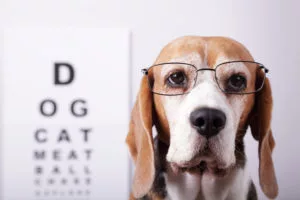Are Dogs Color Blind?
For decades it was common belief that dogs only saw in shades of black, white, and gray. This idea can be paced with Will Judy, publisher of Dog World magazine, who was involved with dogs all throughout his life. He is said to be the first to proclaim that dogs’ vision was poor and thought to only be able to see single shades and tones, with general outlines and shapes. Although this was accepted as fact, we later found out that this was far from the truth. So, are dogs actually colorblind?
Technically, dogs are colorblind, but not in the way that we once thought. Due to research over the last few decades, we now know that dogs can see much better than we were led to believe.
This article will explore what we now know of dogs and what they can see.

What Is Color Blindness in Dogs?
Color blindness is the inability to see the difference between colors or to see some colors at all. This comes from an abnormality in the human eye in the color sensing receptors. People can have two kinds of color blindness:
- Red-green color blindness
- Blue-yellow color blindness
The kind of color blindness will depend on which color-sensing receptors are affected. Because dogs have yellow-blue dichromatic vision, they are similar to a human’s red-green color blindness. While they have a good ability to distinguish between variations of yellows and blues, they can’t see green and red very well.
What Colors Can Dogs See?
A dog’s perception of color is called dichromatic, which means the color is limited when compared to what a human can see. Through research, we believe that dogs see through a unique color spectrum. For dogs, the dominant colors are yellow and blue. That means that blue, blue-green, and violet appear (to dogs) as shades of blue. Shades of green and red probably look like browns and grayscale.

All About Dog Vision
Dogs’ vision is significantly different to what we are used to as humans.
Dog’s Visual Acuity
During the day, the visual sharpness for a dog is 50% less than a human’s. So a dog’s vision may see things blurrier than a person does. But it isn’t a hindrance because dogs use their senses of smell and hearing which are superior to their vision.
Can Dogs See In The Dark?
Unlike during the daytime, dogs are able to see well at night or in low-light. Because they have more rods, their eyes are sensitive to motion. This is what allows them to detect small movements at night. Dogs have a reflective membrane, as do other animals, at the back of the eye. Light that isn’t absorbed by the rods bounces off this membrane. This allows the canine eye to take in more light and improves their nighttime vision. This is also what makes dogs’ eyes glow in the dark.
Why Do Dogs See The Way They Do?
Dogs’ vision equips them to not only survive, but thrive, in the wild. Dogs were originally night hunters and their eyes developed to be able to spot prey. They see well in dim light and detect slight motion at a distance. Not only that, a dog had to be able to spot danger to himself from bigger predatory animals. Most dogs no longer need these abilities, but their vision hasn’t evolved to match their current lifestyle of being a pet. Their vision remains that of a hunter.
Does Breed Affect Dog’s Vision?
It is possible that the difference in a dog’s facial structure can impact a dog’s vision significantly. A dog with a narrow bone structure of the face may have a narrow field of vision compared to a dog with a wider bone structure. The wider the bone structure, the wider the dog’s field of vision.
Dog Vision Compared To Human Vision
Dogs don’t see true color the way people do. It is believed that a canine’s color vision is very similar to a human who has red-green color blindness. Red appears to a dog as dark brownish or gray. And orange, green, and yellow all appear as yellow to a dog. Dogs can see blue very well, and purple appears as blue too.
While a dog doesn’t have the visual acuteness of humans, they have some advantages. Because their eyes are set more on the side of the head, dogs have better peripheral vision than people have. However, dogs don’t have the depth perception that people do. They are also more near-sighed than people are. Humans have clearer vision at a distance that dogs can’t match, but their night vision and ability to detect motion is far better than a human’s.

So, Are Dogs Color Blind?
Dogs are color blind much in the same way that some people are color blind. Although most people were lead to believe that dogs could only see in shades of blue and grey, this is far from the truth. Dogs are technically red-green colorblind, and can actually see colors such as yellow very well!
The difference between people and dogs’ perception of color is in the retina. Millions of cells that sense light make up the retina. These cells include:
- Cones which are used in bright light and control the perception of color.
- Rods which are used in low light and detect movement.
Because dogs were originally night hunters, they have more rods than cones. People have more cones. This is why there is a difference in the perception of colors. Humans have three kinds of cones, which is trichromatic. Dogs have two kinds, which is dichromatic. Each type of cone registers different wavelengths of light. The cone for red and green is present in the human retina but absent in the dog retina.
Conclusion
Although dogs are technically color blind to red and green, they have much better vision than we are led to believe. Dogs can see very well at night, and can pick up on even the slightest movements. Furthermore, their heightened sense of smell and hearing made them skilled hunters before they were domesticated.
Do you have any questions about color blindness in dogs in the Mishawaka, IN region? Lincolnway Veterinary Clinic is available at (574) 256-1871, or you can make an appointment today!

